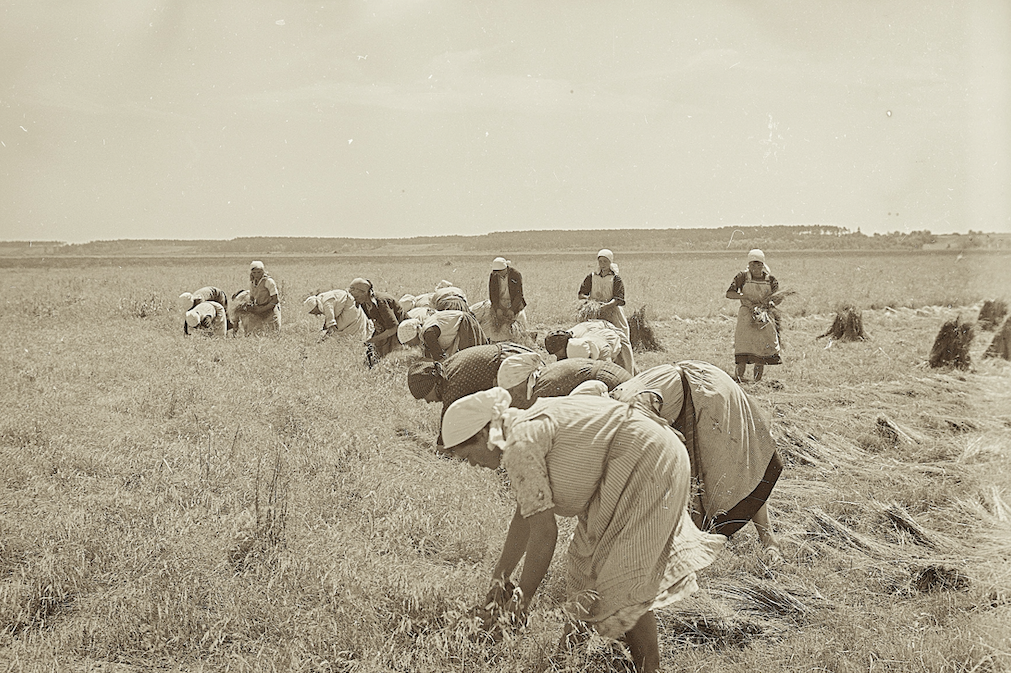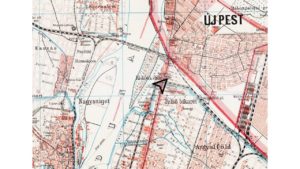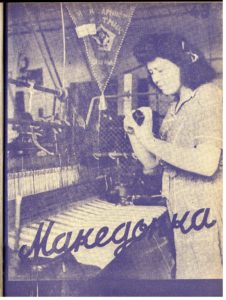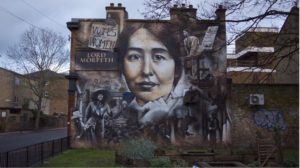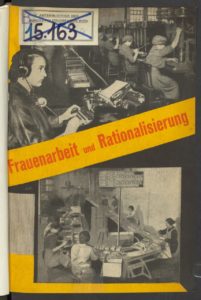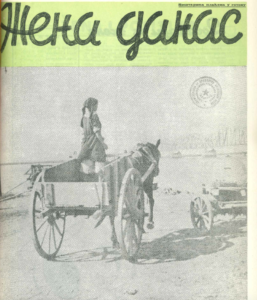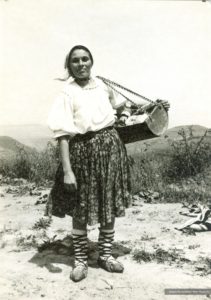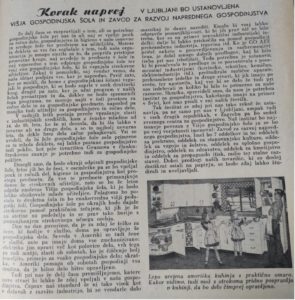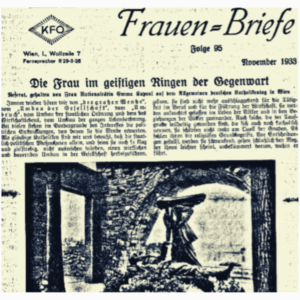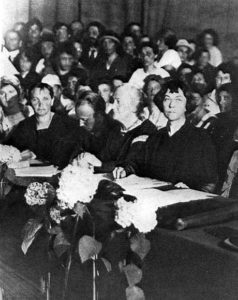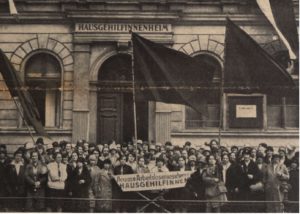by Selin Çağatay and Jelena Tešija
Illustration: Agricultural workers in a Polish village. Work of women in Rząśnik (1938), via Narodowe Archiwum Cyfrowe. Sepia and saturation of the photograph adjusted by the authors.
This year’s ZARAH Blog Series gives the floor to invited contributors and their inspiring explorations, thus publicizing relevant research that takes place beyond the scope of the ZARAH project. Spanning a period from November 2022 to March 2023, Series IV will foreground a variety of topics, each explored through the lens of women’s work and activism. The guest bloggers are invited to think of their own research in terms of women’s labour-related struggles and action. Using the series as a forum for mutually beneficial conversation, we hope to collectively contribute to developing a holistic perspective on women’s efforts to improve their work and everyday life conditions.
How can we think together the many ways in which women pursued their gendered labour interests throughout history? The ZARAH project tackles this question by bringing to light instances of women’s labour activism in Eastern Europe and transnationally. To this end, in the Blog, we have discussed highlights from our research: Series I explored issues connected to finding women in archival sources, Series II focused on the struggles of individual activists, and Series III investigated transnational links in the history of women’s labour activism.
With this introductory post for the Guest Blog Series, we would like to draw attention to a key insight that has already been noted by historians of labour and gender: to understand the multiplicity of gendered labour struggles, one must go beyond the established scopes of inquiry in gender and labour history and look for more ‘unconventional’ spaces of activism and forms and scales of action. This can mean that the investigation must go beyond the traditional foci of the labour and gender history such as trade unions, women-only organizations, or the workplace.
Echoing this insight, Series IV will highlight four ways in which gendered labour struggles in Eastern Europe and beyond can be explored. First, alongside organized labour movements, women pursued gendered labour interests through different kinds of social mobilizations. These mobilizations included other social movements as well as more spontaneous, issue-based actions. What had previously been neglected by labour historians and was somewhat at the periphery of organized labour, has recently gained attention as a significant locus of labour struggles. Gender, however, remains often left out as a relevant category of analysis. A case in point is the consumer cooperatives with their complex position within/vis-à-vis the labour movement.[1] Our suggestion to pay attention to the peripheries and spaces outside of the organized labour movement does not imply that gendered labour struggles within it have already been sufficiently researched. Rather, a new global labour history must also take other spaces of women’s labour activism into account to help rethink what labour activism is and when, how, and why it emerges in different contexts in the first place.
Second, the labour, gender, and social movement studies have often overlooked instances of political and administrative action that took place within the state, perhaps because labour activism has often been in direct conflict with the state and state institutions. However, researchers who adopt inclusive perspectives on organizational forms of activism call for broadening the definition of the women’s movement to include state institutions such as, for example, policy agencies dealing with gender issues.[2] Nevertheless, official women’s organizations and trade unions in the state-socialist Eastern European countries are still often missing in these debates. Discussing contributions to labour struggles (and all potential problematic zones) of officials operating in different economic and political systems in an integrative analytical framework can enhance our understanding of activism in and out of the state.[3] It would also help us overcome the scholarly biases involved in studying different groups of women activists.
Third, work by researchers and professionals who investigated different aspects of women’s work can also be considered as part of women’s labour activism. In Eastern Europe and beyond, researchers not only in universities but also in trade unions, women’s organizations, and state departments have documented women’s work-related problems. As labour inspectors, policy-makers, and ministry officials, they also offered ways to address these problems. In state-socialist countries, historians and sociologists dedicated to women’s emancipation incorporated women’s struggles in labour movement histories and integrated gender issues into policy-making processes, respectively.[4] In many instances, these researchers and professionals were involved in or strongly identified with the organized labour movement. In others, they posed new research questions and used new methodologies to uncover the dynamics of gendered inequalities in social and economic spheres, for example by turning to marginalized groups of women such as rural women, migrant women, and ethnic and religious minorities in the world of work.[5]
Finally, the life trajectories of individual women offer novel perspectives on how gendered labour struggles took shape across different social milieus and political landscapes. Research on life stories of women activists, intellectuals, and artists is available in many forms including fictional and non-fictional biographies, biographic dictionaries, and ego documents. Within state-socialist and other left-wing labour historiographies, life stories often portrayed popular and heroic figures whose participation in revolutionary movements or moments gave legitimacy to regime-building efforts and/or marginalized labour struggles. In the past few decades, feminist researchers maintained the focus on significant figures,[6] but they also developed more comprehensive accounts of women’s lives by focusing on their multiple engagements and overlapping identity belongings.[7] Recently, researchers have also turned to the stories of ordinary women and lesser-known activists with a curiosity to understand the experience of and participation in social mobilization and political change on the individual level.[8] A focus on the individual reveals that labour issues have been integral to women’s gendered struggles even when these women did not self-identify, or not in the first place, as labour activists.
The eight posts in the Guest Blog Series deal with at least one, and most cover more than one of the four dimensions we outlined above. The series opens with Jessica Richter’s piece that discusses the everyday gendered labour struggles of domestic workers outside of labour organizations in Austria from the late 19th century until 1938. Minja Bujaković focuses on the role of individual activism by women, such as Clara Zetkin, in developing the communist women’s transnational movement in the early 1920s. Doreen Blake’s contribution shows how Catholic women’s organizations approached and portrayed gendered labour issues in their journals in Interwar Austria. Ivana Mihaela Žimbrek discusses official women’s organizations’ activism in relation to reproductive work and their efforts to reduce women’s “double burden” in socialist Yugoslavia in the 1950s and 1960s. In her contribution, Adela Hîncu analyses how women sociologists in their research on family and agricultural work in state socialist Romania in the 1970s and 1980s addressed and made visible rural women’s labour. Focusing on various aspects of Interwar activism by the Yugoslav communist activist and literary writer Milka Žicina, Isidora Grubački discusses the entanglements of intellectual and labour history. The contribution by Adrienn Kácsor focuses on the working conditions of the communist activist and artist Jolán Szilágyi and her position as a female migrant artist in Weimar Germany. Clara Vlessing’s piece on the ambivalences in remembering the British suffragette and communist Sylvia Pankhurst (1882-1960) and the uses of historical figures’ activism in building up contemporary movements closes the series.
Update: The series has been subsequently enriched with two additional valuable contributions. Ivana Hadjievska discusses women’s representation in the Macedonian socialist magazine Makedonka from 1947 to 1951. Sára Bagdi sheds light on under-researched women’s labour activism in the early 1900s Hungary and analyses contributions by socialist Klára Balázs to labour struggles in the Újpest jute factory.
References:
[1] Mary Hilson, Silke Neunsinger, and Greg Patmore, eds. A Global History of Consumer Co-Operation since 1850: Movements and Businesses. A Global History of Consumer Co-Operation since 1850. Leiden; Boston: Brill, 2017.
[2] Laure Bereni and Anne Revillard. ‘Movement Institutions: The Bureaucratic Sources of Feminist Protest’. Politics & Gender 14, no. 3 (2018): 407–32.
[3] See, for example, Kristen R. Ghodsee. ‘Pressuring the Politburo: The Committee of the Bulgarian Women’s Movement and State Socialist Feminism’. Slavic Review 73, no. 3 (2014): 538–62.; Lee Ann Banaszak and Anne Whitesell 2017. ‘Inside the State: Activism within Legislative and Governmental Agency Forums.’ In The Oxford Handbook of U.S. Women’s Activism, edited by Holly McCammon, Verta Taylor, Jo Reger, and Rachel Einwohner. New York: Oxford University Press. pp. 487-506.; Magdalena Grabowska. ‘Bits of Freedom: Demystifying Women’s Activism under State Socialism in Poland and Georgia’. Feminist Studies 43, no. 1 (2017): 141-168.; Rebecca Neaera Abers. ‘Institutions, Networks and Activism Inside the State: Women’s Health and Environmental Policy in Brazil’. Critical Policy Studies, 15, no. 3 (2021): 330-349.
[4] Alexandra Ghit. ‘Professionals’ and Amateurs’ Pasts: A Decolonizing Reading of Post-War Romanian Histories of Gendered Interwar Activism’. European Review of History 25, no. 1 (2018): 21-44.
[5] See, for example, Günseli Berik. Women Carpet Weavers in Rural Turkey: Patterns of Employment Earnings and Status. Geneva: International Labour Organization, 1987.
[6] Francisca de Haan, Krassimira Daskalova, and Anna Loutfi, eds. A Biographical Dictionary of Women’s Movements and Feminisms. Central, Eastern, and South Eastern Europe, 19th and 20th Centuries. Budapest, New York: CEU Press, 2006.
[7] Robert Levy. Ana Pauker: The Rise and Fall of a Jewish Communist. Berkeley: University of California Press, 2001.
[8] Jill Massino. Ambiguous Transitions: Gender, the State, and Everyday Life in Socialist and Postsocialist Romania. New York: Berghahn Books, 2019.; Maria Todorova. The Lost World of Socialists at Europe’s Margins. Imagining Utopia, 1870s – 1920s. London: Bloomsbury Academic, 2020.

